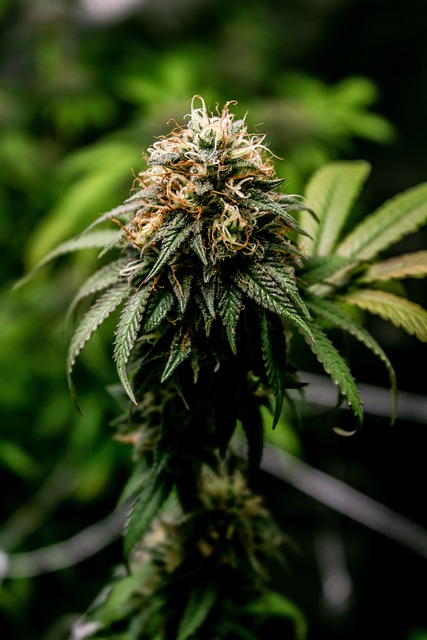High potency cannabinoids (HPCs) in cannabis, with THC levels often exceeding 20%, offer significant therapeutic advantages due to the entourage effect. Clear labeling is crucial for consumer safety and trust in the cannabis industry, providing detailed information about ingredient lists, cannabinoid profiles, dosages, potential side effects, and safe handling instructions. This empowers users to make informed decisions based on their individual needs while mitigating risks of adverse reactions and ensuring regulatory compliance. Clear labels facilitate responsible and personalized choices, satisfying diverse preferences and fostering a robust market.
In the rapidly evolving cannabis industry, understanding high potency cannabinoids is essential for both consumers and manufacturers. Clear labeling plays a pivotal role in ensuring product safety, quality, and regulatory compliance. This comprehensive overview explores the significance of accurate labeling practices, educating users about cannabinoid potency, and best strategies to inform buyers effectively. By implementing these guidelines, the industry can enhance consumer awareness and trust, fostering a more transparent market for high-potency cannabis products.
Understanding High Potency Cannabinoids: A Comprehensive Overview

In the realm of cannabis products, understanding high potency cannabinoids is essential for consumers seeking accurate labeling and informed decisions. These potent compounds, often denoted by their tetrahydrocannabinol (THC) content, offer unique therapeutic benefits but also require careful consideration. High potency cannabinoids refer to cannabis strains or extracts with significantly elevated levels of THC, exceeding 20% in some cases. This concentrated form of the primary psychoactive compound can deliver intense effects, making it a popular choice for medical and recreational users alike.
A comprehensive overview reveals that high potency cannabinoids are not merely about increased strength. They encompass a complex interplay of various cannabinoids, including cannabidiol (CBD), that work synergistically. This synergy, known as the entourage effect, enhances the overall therapeutic potential. By labeling these products clearly, consumers can make informed choices based on their specific needs and preferences. Accurate labeling ensures users understand the potency, potential effects, and suitability for their intended use, be it for managing chronic pain, alleviating anxiety, or seeking recreational enjoyment.
The Importance of Clear Labeling in the Cannabis Industry

In the cannabis industry, clear labeling is paramount for ensuring consumer safety and building trust. With products containing high potency cannabinoids, accurate and detailed labels are critical. Consumers rely on these labels to understand what they’re purchasing, including ingredient lists, cannabinoid profiles, dosages, and potential side effects. Clear labeling allows users to make informed decisions about their consumption, especially as they navigate the diverse range of cannabis products available in today’s market.
Moreover, precise labeling plays a crucial role in mitigating risks associated with incorrect use or misidentification. It helps prevent adverse reactions by providing transparent information about product composition. This is particularly important given the evolving legal landscape and varying regulations around cannabinoids. Clear labels act as a shield for businesses, protecting them from liability, while empowering consumers to make responsible choices.
How Clear Labeling Ensures Product Safety and Quality

Clear labeling is an indispensable practice in ensuring product safety and quality, especially in industries dealing with high-potency compounds like cannabinoids. When it comes to products containing potent substances, consumers must be provided with accurate and comprehensive information to make informed decisions about their use. Well-labeled packages offer a multitude of benefits that contribute to a safer market for both producers and users.
For instance, clear labels specify the exact cannabinoid content, allowing buyers to understand the potency levels and potential effects. This transparency empowers consumers to align product usage with their desired outcomes while mitigating risks associated with underdosed or mislabeled products. Moreover, clear labeling includes detailed instructions on safe storage, use, and disposal methods, reducing the likelihood of accidents or adverse reactions. By legally mandating such labels, regulatory bodies aim to protect public health, ensuring that consumers are fully aware of what they purchase and how to handle it responsibly.
Consumer Awareness: Educating Users About Cannabinoid Potency

In today’s market, consumers are increasingly demanding transparency and clarity in their purchases, especially when it comes to products with potential health benefits like those containing cannabinoids. Educating users about the potency of these compounds is a crucial step in ensuring consumer awareness and safety. Many consumers may not realize that products can vary greatly in terms of cannabinoid concentration, which directly impacts effectiveness and desired outcomes. By clearly labeling products with accurate potency information, manufacturers enable informed decisions.
This practice empowers consumers to understand exactly what they are using, whether it’s a low-potency option for casual users or high potency cannabinoids for those seeking more intense effects. Access to such data allows individuals to align their choices with personal preferences and needs, fostering a responsible and satisfying experience.
Regulatory Compliance: Meeting Standards for Accurate Labeling

Regulatory compliance is a cornerstone of the cannabis industry, especially when it comes to accurate labeling. This involves adhering to strict standards set forth by governing bodies to ensure that products containing high potency cannabinoids are properly identified. Clear and concise labeling provides essential information about the product’s composition, potential effects, and usage instructions.
Compliance ensures consumers receive transparent data, helping them make informed decisions. It also safeguards against legal repercussions for manufacturers and retailers. By meeting these standards, businesses can maintain integrity, build trust with customers, and contribute to a responsible cannabis market.
Best Practices for Effective and Informative Product Labeling

When it comes to product labeling, especially for items containing high potency cannabinoids like CBD or THC products, clarity and comprehensiveness are key. Effective labeling should provide consumers with all necessary information in an easily digestible format. Start by ensuring your labels include a clear product name that accurately reflects its contents. For instance, “Organic CBD Oil – Full Spectrum” gives a straightforward indication of the product’s composition.
Additionally, detailed descriptions should highlight the product’s key ingredients, their concentrations, and any potential effects or precautions. For high potency cannabinoids, it’s crucial to mention potential side effects and interactions with other substances. Use simple language to avoid confusion and ensure consumers can quickly understand what they’re purchasing. Visual elements like diagrams or illustrations can also aid in conveying information, making your product labels more engaging and user-friendly.
